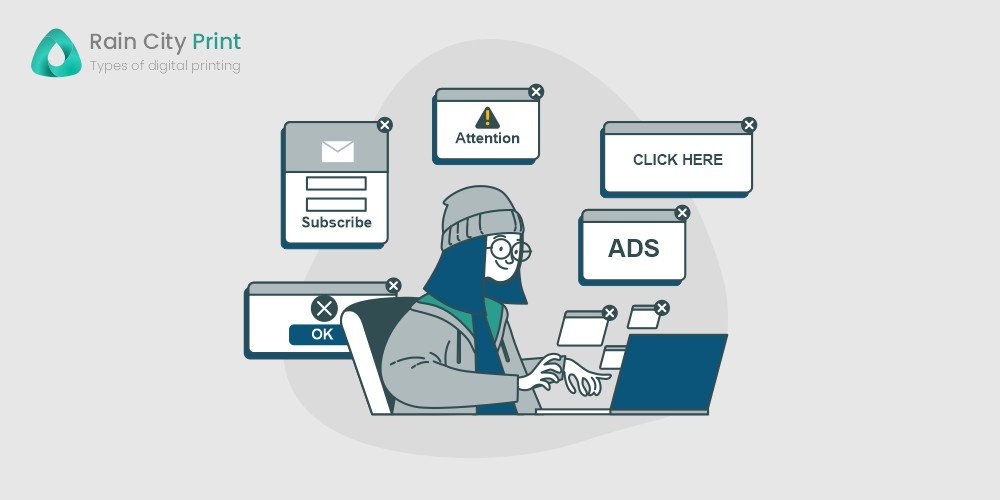Various types of ads cater to diverse audiences, platforms, and objectives, each offering unique advantages. Here’s a comprehensive exploration of different types of ads for businesses commonly employ to bolster their presence and drive growth:
1. Display Ads
Display ads encompass visually appealing graphics and text, typically showcased on websites, apps, or social media platforms. These ads come in various formats such as banners, sidebars, interstitials, and pop-ups. They leverage eye-catching designs to capture attention and direct users to a website or a specific landing page.
2. Search Ads
These ads appear at the top or bottom of search engine results pages (SERPs) in response to specific keywords. They are usually text-based and link directly to a landing page optimized for conversions. Google Ads and Bing Ads are prominent platforms for running search ads, targeting users actively seeking products or services related to the keywords.
3. Social Media Ads
Platforms like Facebook, Instagram, Twitter, LinkedIn, and TikTok offer businesses diverse ad formats – photo ads, video ads, carousel ads, and more. Social media ads leverage detailed targeting options based on demographics, interests, behaviors, and connections, ensuring content reaches the intended audience.
Social Media Ads are most popular of the other types of Ads for businesses.
4. Video Ads
Video ads play before, during, or after online video content on platforms like YouTube, Facebook, or Instagram. They can be skippable or non-skippable and come in various lengths and styles, allowing businesses to engage audiences through storytelling, demonstrations, or brand narratives.
5. Native Ads
Native ads blend seamlessly into the content environment, resembling the format and style of the platform they appear on. They aim to deliver non-disruptive, relevant content to users, often found in social media feeds, recommended articles, or sponsored content sections.
6. Remarketing/Retargeting Ads
These ads target users who have previously interacted with a website or shown interest in certain products or services. By using cookies, businesses can display tailored ads to these users across various websites or platforms, encouraging them to return and complete a desired action.
7. Influencer Marketing
Influencer marketing involves collaborating with social media personalities or industry experts to promote products or services. These influencers have dedicated followings and can significantly impact their audience’s purchasing decisions through authentic endorsements or reviews.
8. Email Marketing
Email marketing remains an effective way to reach existing or potential customers directly. Ads can be embedded within newsletters or standalone promotional emails, offering personalized content, special offers, or product updates.
9. Outdoor Ads
Billboards, transit ads, posters, and signage fall under outdoor advertising. These ads target local audiences and cater to people in specific locations, maximizing visibility in high-traffic areas.
10. Print Ads
Magazines, newspapers, brochures, and flyers continue to serve as platforms for print advertising. They offer tangible visibility and can reach niche audiences based on publication demographics.
11. Audio Ads
Audio ads appear on streaming platforms like Spotify, podcasts, or radio broadcasts. They leverage sound to convey messages, utilizing jingles, voiceovers, or endorsements to engage listeners.
12. Product Placement
Businesses collaborate with TV shows, movies, or events to feature their products or services within the content. This indirect form of advertising integrates offerings seamlessly into the narrative, reaching audiences in an organic manner.
13. Interactive Ads
Interactive ads encourage user engagement by allowing consumers to interact with the ad content. These ads could involve quizzes, games, or polls, providing an immersive experience that enhances brand recall.
14. Augmented Reality (AR) Ads
AR ads leverage technology to overlay digital content onto the real world through smartphone cameras or specialized devices. They enable users to interact with virtual elements, allowing businesses to showcase products in a lifelike manner.
15. Sponsorships and Partnerships
Businesses collaborate with events, organizations, or other brands through sponsorships or partnerships. This association helps in brand exposure, reaching a broader audience and building credibility through shared values or interests.
Summary of Types of Ads for Businesses
By leveraging a mix of these advertising types, businesses can tailor their strategies to specific goals, target audiences effectively, and maximize their reach across various channels, ultimately driving brand awareness, engagement, and conversions. If you need more information on the Types of Ads for Businesses, you can contact us.











